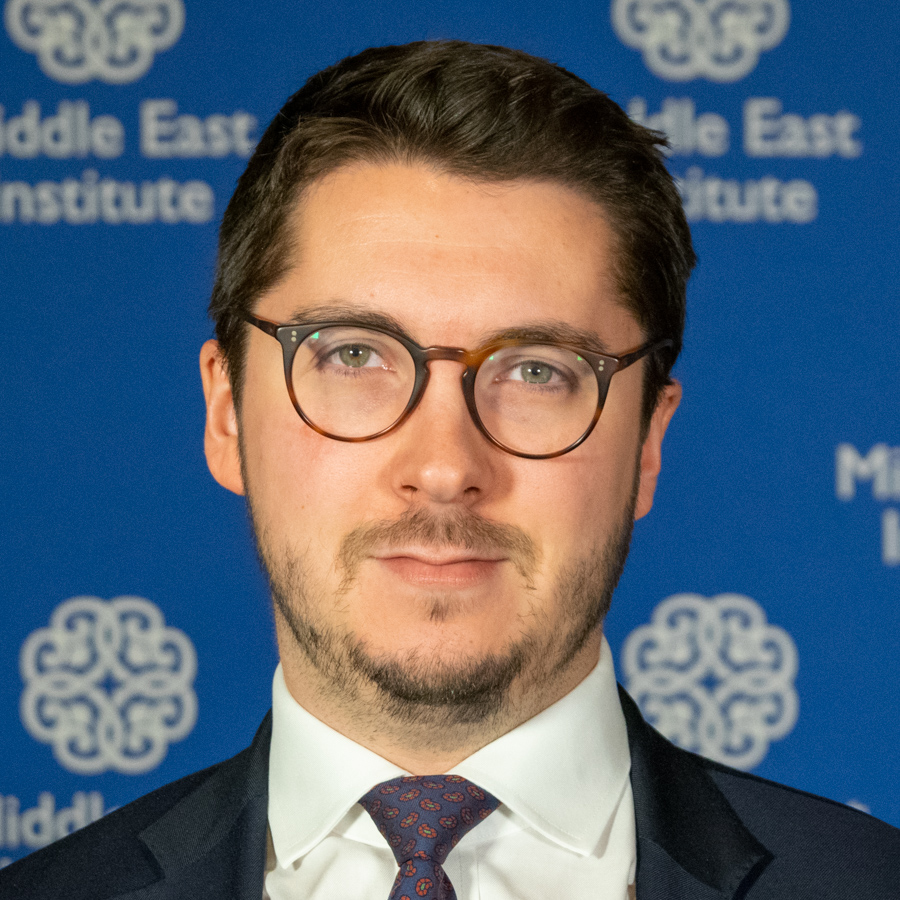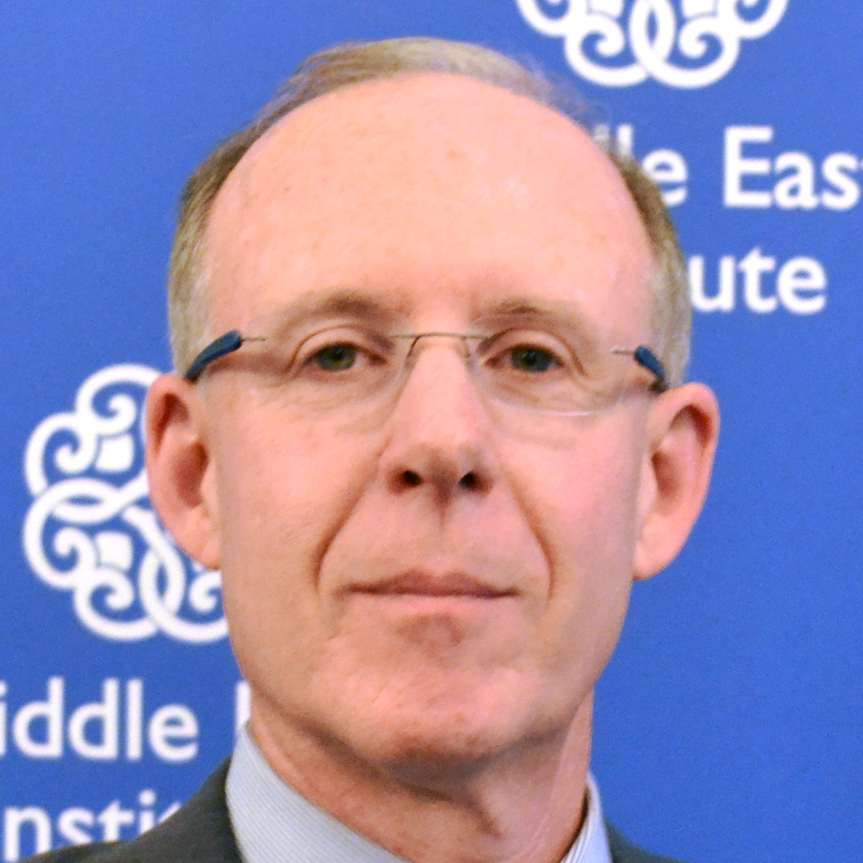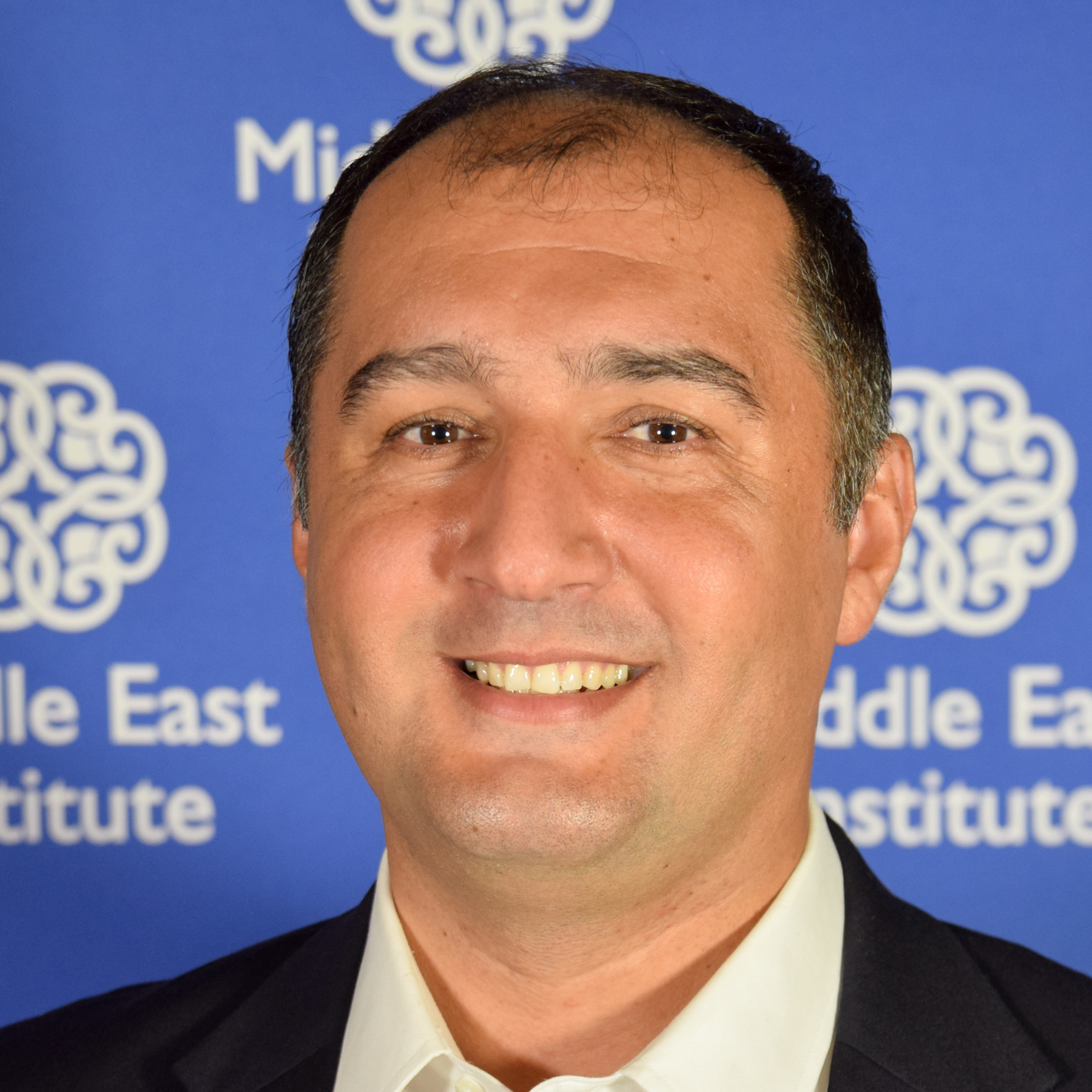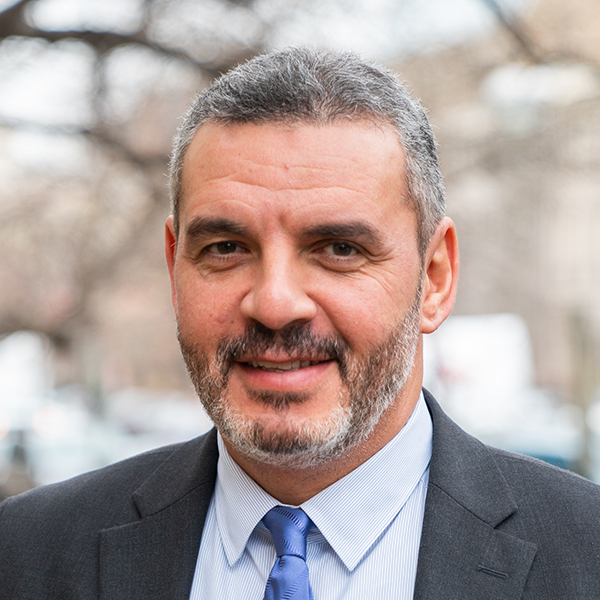Contents:
- A transition in America occurs as the landscape shifts in the Middle East
- New regional diplomacy
- The catch-22 of civil wars in the Middle East
- Iran’s hardliners consolidate their hold on power
- The end of the 20-year war in Afghanistan
- The lessons of the May war in Gaza
- Israel’s new government lowers the temperature of the debate
- A year of reckoning in energy markets
- More climate change highs (and lows) for the Middle East
- Technopolitics emerge as a key factor in the new geopolitics
1) A transition in America occurs as the landscape shifts in the Middle East
Paul Salem
President
Brian Katulis
Vice President for Policy
The center of gravity for the Biden administration’s overall policy was on domestic issues, with a sharp focus on the pandemic and economic crisis at home. On the foreign policy front, the three C’s — China, climate change, and COVID-19 — along with efforts to rebuild ties with democratic allies in Europe and Asia, dominated the agenda.The transition of power in the United States from the Trump administration to the Biden administration was one of the year’s most important events for the broader Middle East and North Africa, as it resulted in significant shifts in U.S. policy that had ripple effects across the region. The most consequential of these moves were the withdrawal from Afghanistan and the attempt to return to the 2015 nuclear agreement with Iran. Nevertheless, many of the most important trends in the Middle East remain driven by its governments and people, as well as the impact of factors such as the COVID-19 pandemic, climate change, and migration on the regional landscape. Yet, for all of the talk about U.S. disengagement from the region and the rise of China and Russia, the United States remains the most influential outside actor, given its broad network of relationships and ability to influence dynamics.
The Biden administration signaled a more modest approach to the Middle East compared to the Trump administration, prioritizing diplomacy in its rhetoric and actions and stressing that it was moving “back to basics” in avoiding overpromising about the level of U.S. engagement. It worked to adopt a steadier, more predictable policymaking process than its predecessor had on the Middle East.
The Trump administration was focused on the military defeat of the Islamic State, the “maximum pressure” campaign against Iran, and efforts to forge normalization agreements between Israel and Arab states including the United Arab Emirates (UAE), Bahrain, Morocco, and Sudan. By contrast, the Biden administration’s initial stance has been to guard against the deep levels of engagement that had at times overwhelmed the broader agendas of the past three U.S. administrations. It appointed envoys on Yemen, Libya, and the Horn of Africa, and it reengaged Iran in international talks on its nuclear program in Vienna.
The May 2021 war between Israel and Hamas drew the Biden administration back into the Israeli-Palestinian issue more deeply than it had planned. The haphazard withdrawal of U.S. troops from Afghanistan caused a crisis of confidence among America’s partners in the Middle East and prompted more engagement with several of them, especially the Arab Gulf states, than the administration had initially intended.
But it was the common thread between the Obama, Trump, and Biden administrations that made the biggest impression on the region: the desire to limit U.S. involvement in the Middle East. The U.S. posture has incentivized strategic hedging among key countries in the region, which have consequently worked to forge deeper ties with other outside actors, especially China, Russia, and some European countries. It also created incentives for many regional states to adopt a more assertive approach.
Within the region itself a number of dynamics have marked 2021. The COVID pandemic continued to claim thousands of lives, strain public health resources, constrain economic growth and public finances, and drive up rates of poverty, unemployment, and inequality. Vaccination rates and COVID response efforts have varied widely across the region, from the top performers in the resource-rich Gulf states, to more challenging conditions in the population-rich and resource-poor countries, and desperate conditions in the fully or partially failed states of Yemen, Libya, and Syria.
Despite these challenges, the broader regional economy bounced back: Average GDP growth in 2021 returned to around 4% after contracting by 4% in 2020. Oil prices continued to recover in 2021 after the total collapse in early 2020 and rose steadily over the course of the year; this helped improve growth among oil-producing economies and also boosted remittances and investment flows to some non-oil-rich countries as well. Even as energy prices recovered, key energy producers — including Saudi Arabia — have started on a transition toward a cleaner energy mix, and are trying to position themselves as major players in natural gas, green and blue hydrogen, solar, and wind.
On the political level, the democratic transitions in Tunisia and Sudan — all that remained of the two waves of the Arab Spring in 2011 and 2019 — came to halt; whether that halt is final or merely temporary remains to be seen. Among the civil wars in the region, the Libyan conflict showed the most signs of progress, with ongoing negotiations among the parties, international support, and plans to hold fresh elections. The war in Yemen continued unabated, with the Houthis declining Saudi and international offers to negotiate and focusing instead on trying to take the strategic town of Marib, while the Saudis provided air support to government and local anti-Houthi forces to hold it. In Syria, the conflict remained largely frozen in 2021, with no major military operations, but also no progress toward any solution. Meanwhile, a new civil war erupted in Ethiopia between government forces and Tigrayan groups, with potential ripple effects for the Horn of Africa and the broader region.
At a regional level, key actors took steps to deescalate tensions and build — or rebuild — working relationships. Saudi Arabia took the lead in healing the rift with Qatar and trying to rebuild solidarity within the Gulf Cooperation Council. Saudi Arabia also initiated talks with Iran under Iraqi auspices in Baghdad. The UAE sent Foreign Minister Sheikh Abdullah bin Zayed al-Nahyan to reestablish ties with the regime of Syrian President Bashar al-Assad, Crown Prince Mohammed bin Zayed al-Nahyan visited erstwhile foe President Recep Tayyip Erdoğan of Turkey and offered billions of dollars in economic investment, and UAE National Security Advisor Tahnoun bin Zayed al-Nahyan was dispatched to Tehran to meet with Iranian President Ebrahim Raisi. This came on the heels of the historic Abraham Accords of 2020 and the strengthening of cooperation between the UAE and Israel.
But even as countries in the region took diplomatic steps to de-escalate tensions, heal rifts, and build new bridges, the security landscape continued to grow more complicated and fragmented, with an increasing number of state and non-state actors deploying and using unmanned weapons including aerial systems. The trend toward using armed drones that began before 2021 continued and accelerated — the attempted assassination of Iraq’s prime minister by militia groups and attacks on U.S. military bases in Syria and Iraq were just two prominent examples in the past year. The lower barriers to entry in this arms race complicate regional security dynamics by introducing new threats and increasing the overall uncertainty in the broader environment.
The most significant geopolitical event in the region was the haphazard U.S. withdrawal from Afghanistan, which sparked widespread concern across the region. The Taliban’s resounding triumph plays directly into the jihadist narrative and will reinvigorate the recruitment and ambitions of like-minded groups such as ISIS and al-Qaeda. The U.S. retreat also shook the confidence of America’s partners throughout the region that rely on U.S. backbone in their national security strategies and gave encouragement to states like Iran, reinforcing their view that the U.S. is a paper tiger that will buckle if enough pressure is exerted. Concerns about America’s inability to curb either Iran or the Taliban is part of the reason for the rapprochement between Israel and several Gulf states — which share a common fear of Iran — as well as the growing contacts between Middle East states and other great powers, such as Russia and China. While neither is a viable full strategic alternative for America’s partners in the region — they will remain mainly U.S. allies — hedging of bets and efforts to find areas of common security and economic interest proceed apace.
2) New regional diplomacy
The GCC turns to diplomacy and dialogue to manage conflict
Gerald M. Feierstein
Senior Vice President

After decades of confrontation and the threat of war, the Gulf Cooperation Council (GCC) states, especially Saudi Arabia and the UAE, emphasized in 2021 their desire to “turn a page” and seek to manage, if not resolve, regional conflicts through dialogue and negotiation. Beginning with the al-Ula agreement that ended the intra-GCC feud with Qatar, the two predominant GCC states have expanded their dialogue with Iran, calmed tensions with Turkey, pursued a diplomatic resolution to the conflict in Yemen, and promoted Syrian reintegration into the Arab League. While not all of these initiatives have borne fruit, and several may not produce tangible benefit anytime soon, they are nevertheless a reflection of a changing strategy toward addressing regional challenges and have the added benefit of reducing internal GCC friction over regional policies. The communique released at the conclusion of the 42nd GCC Summit on Dec. 14 was notable for the change in the tone and tenor of the leaders’ discussion on regional challenges as well as its emphasis on intra-GCC coordination on key political, economic, and social issues.
There are several likely reasons for the changing Gulf approach to conflict. Leaders have been clear that they are exhausted by decades of confrontations that have failed to improve their security materially or benefit their populations. The COVID-19 pandemic, economic and demographic challenges, as well as the threat from climate change have brought home the need to strengthen domestic institutions and reduce external distractions. Uncertainty about the dependability of the U.S. security umbrella, a key pillar of GCC defense strategies since the Carter Doctrine, has reinforced the need in the GCC to move away from long-standing reliance on the U.S. military presence. Although many of the steps (but not all of them) have been welcomed by the Biden administration, nevertheless, the emphasis on finding regional solutions to regional problems will challenge U.S. policies and assumptions going forward.
Facing long odds and growing pressure at home, Erdoğan tries a new approach: diplomacy
Gönül Tol
Director of Turkey Program and Senior Fellow, Frontier Europe Initiative

In mid-August 2020, a Turkish and a Greek warship were involved in a mild collision during a standoff in the eastern Mediterranean — one many called the most explosive the region had seen in 20 years. The row between the two NATO allies over energy exploration was the latest in a series of aggressive foreign policy moves by Turkey. Since President Recep Tayyip Erdoğan allied himself with the Nationalist Action Party (MHP) to recapture the parliamentary majority his party lost in the 2015 elections, Turkey had been pursuing a militaristic and unilateral foreign policy that has pitted Ankara against almost everyone in the region. 2021 was the year that finally changed.
President Erdoğan is now facing the longest odds of his political career. He has myriad problems but the chief among them is a collapsing economy. The Turkish currency has lost nearly half its value since the start of September. The crisis has driven up the cost of food, gasoline, and medicine, and hit poor and middle-class Turks, who have been key to his two-decade-long rule, hard. In the past, whenever domestic problems seemed overwhelming, Erdoğan turned to aggressive foreign policy moves to divert attention and benefit from a nationalist “rally ‘round the flag” effect. This strategy worked well for years but it has run its course. Nationalism is not doing the trick for Erdoğan anymore and his aggressive, adventurist, unilateral foreign policy, which has left him internationally isolated, has become costlier at a time of growing economic problems. So the Turkish president decided to change course and has been reaching out to regional adversaries as well as Western countries to mend ties.
Erdoğan recently hosted the de facto leader of the United Arab Emirates, Abu Dhabi Crown Prince Sheikh Mohammed bin Zayed al-Nahyan, after years of hostility. Erdoğan also pledged to repair ties with Egypt, Saudi Arabia, Israel, and Armenia and has been trying to have a positive agenda with Europe and the U.S. Erdoğan is hoping that billions of dollars of investment that Emirati officials promised during the crown prince’s visit and other potential economic benefits that normalization with other countries could bring will help ease his economic troubles. 2022 will show how realistic Erdogan’s expectations are.
Follow on Twitter: @gonultol
The year of Assad’s normalization
Charles Lister
Senior Fellow, Director of Syria and Countering Terrorism & Extremism programs

In the not-too-distant future, 2021 will stand out as the year when a methodical process began to reintegrate Bashar al-Assad and his regime in Syria into the “international community.” Despite the enormity of the Assad regime’s war crimes since 2011 — prosecutors have more evidence against Syria than the world had against Hitler and the Nazi Party at Nuremberg — a combination of fatigue, disinterest, and resignation has created conditions in which re-engaging with the 21st century’s most notorious war criminal is seen by some as “realist” and “pragmatic” policy.
For many U.S. allies in the Middle East, their decision to re-engage is also being driven by a U.S.-created vacuum resulting from a clear disinvestment in Syria and a policy of no longer confronting Assad’s regime. In addition to Syria’s shocking election to the World Health Organization’s Executive Board and Interpol’s re-integration of Syria into its network, the Assad regime has benefited from signals sent by the Biden administration. A U.S.-facilitated regional energy deal to benefit Lebanon has seen Syria included as an active player and a recipient of foreign gas and electricity; to avoid triggering Caesar Act sanctions, the Biden administration has clarified loopholes. As part of back-channel negotiations with Russia, the U.S. has also softened restrictions on foreign entities, allowing financial engagements with Assad’s regime and funding for early recovery activities in regime areas that go far beyond humanitarian aid and will benefit the regime both directly and indirectly.
Encouraged by this softening of U.S. policy, the United Arab Emirates has dramatically escalated its re-engagement with Assad’s regime: dispatching Foreign Minister Abdullah bin Zayed to Damascus, re-starting bilateral business collaboration, and signing a $300 million power plant deal. Exasperated by U.S. indifference and struggling economically, Jordan has aggressively re-engaged, exchanging multiple ministerial visits and re-opening trade. King Abdullah even took a “brotherly” call from Assad himself. Similarly, Egypt hosted Syria’s General Intelligence chief and Algeria is pushing hard for its re-entry into the Arab League.
Notwithstanding the potent dangers inherent in normalizing a brutal dictator and undermining any chance of a meaningful settlement, moves to reintegrate Assad into the regional architecture are stunningly short-sighted. They will embolden a brutal regime, guarantee Syria’s long-term instability, and in all likelihood, implicate key U.S. allies in indirectly aiding and abetting continued war crimes. For now, Qatar and Saudi Arabia stand vocally opposed to the prevailing regional winds, but for how long that will last is distinctly unclear.
Follow on Twitter: @Charles_Lister
3) The catch-22 of civil wars in the Middle East
Ross Harrison
Senior Fellow and Director of Research

Civil wars in the Middle East, while symptomatic of the failure of states to build legitimacy and inclusive governance, also are emblematic of a fractured and failed region. Despite some attenuation of the civil wars in terms of the levels of violence and the degrees of lethality in 2021, these conflicts held the Middle East in a vice-grip of regional dysfunction for most of the year, something that is likely to carry over to 2022.
In 2021, active fighting in many of the civil wars largely abated. In Afghanistan this came about because of the outright victory of the Taliban over the Kabul government and the complete withdrawal of the United States. In Syria, victory was delivered to the Assad government over most, but not all, of the country, but only with Russia and Iran putting their collective thumbs on the scale. In the case of Libya, outside actors have played a role in forging agreement between the antagonists and have brought the country to the cusp of elections, which as of this writing seem to be delayed. In Yemen, there have been attempts by outside powers to move the parties toward resolution, but the Houthis, perhaps with Iranian support, have been resistant.
But despite an apparent reduction in the levels of overall fighting in several of these conflicts, for much of 2021 they persisted in creating regional dysfunction, and have defied attempts to create a permanent resolution that would give comfort to suffering populations.
It is easy to point fingers as to why this happened. Clearly there is no shortage of bad actors who have put their own interests ahead of those of their populations. Focusing on the actors themselves, however, misses a broader structural problem of the “unvirtuous cycle” of regional and international actors feasting on the civil wars, but the civil wars giving back by stoking conflicts between the regional actors, such as Saudi Arabia and Iran or Israel and Iran.
This structural problem manifested for the Middle East in a catch-22, whereby resolution of the wars required some form of regional and international cooperation, but the dynamics of the wars created security dilemmas and conflict traps that made the hurdles to getting to cooperation insuperable, even for actors who might be predisposed to cooperate. Going into 2022, these dynamics could mean that, notwithstanding signs in 2021 of an easing of tensions between the Gulf Cooperation Council (GCC) states and Iran, a broader and more lasting rapprochement could prove elusive.
Let’s look at the following developments in the civil wars which defined 2021, posed a threat to the lives of people residing in the countries at war, and are likely to carry over to 2022:
-
Syria remains one of the countries on the planet most penetrated by outside powers. In 2021, Russia, Iran, and Turkey became more, not less, entrenched militarily in Syria. Transitioning from where Syria is today to a more stable, inclusive, and de-militarized country free of outside actors seems years, if not decades, away.
-
Other countries that have transitioned into a post-civil war reality are now at renewed risk of falling back into civil war. Lebanon in 2021 continued to experience the malaise that followed the explosion at Beirut Port in August 2020. This has contributed to further state failure, which could pull the country into civil violence. This would likely intensify the already significant involvement of outside regional actors, with Iran being the most likely protagonist and beneficiary. Iraq too is in a precarious state and remained for much of 2021 at risk of falling back into sectarian violence.
-
While the civil war in Ethiopia is somewhat removed from the broader Middle East, a prolonged conflict could invite meddling of regional actors like Egypt, which already has disagreements with the government in Addis Ababa over the Grand Ethiopian Renaissance Dam (GERD). It could also add to instability in Sudan, and might invite further involvement from international actors and terrorist organizations as well.
-
The countries that seem to be in some form of post-civil war state of suspended animation, like Iraq and Afghanistan, have become more, not less, vulnerable to spoilers, such as ISIS and even al-Qaeda, which could be reinvigorated by the U.S withdrawal from Afghanistan.
-
In 2021, attempts have so far failed to bring the United States back into the Joint Comprehensive Plan of Action (JCPOA), and Iran back into compliance with the terms of the nuclear deal. This has given Iran a greater incentive to double down in the civil war zones instead of working cooperatively with other states to bring the wars to a close.
The Middle East for all of 2021 has been caught in a conflict trap, where civil wars stoked regional tensions and tensions between regional actors made ending the civil wars difficult. While as the year draws to a close, there are several promising signs of a thawing of tensions between regional actors, namely the GCC states and Iran, we need to be cognizant of how the current situation in the civil wars zones of the region could act as a headwind that will slow progress toward ultimate regional security and stability.
4) Iran’s hardliners consolidate their hold on power
Alex Vatanka
Director of Iran Program and Senior Fellow, Frontier Europe Initiative

In Iran, the biggest headline of 2021 was the hardliners’ recapture of all centers of power in Tehran. Supreme Leader Ayatollah Ali Khamenei and his armed stalwarts in the Islamic Revolutionary Guard Corps (IRGC) masterminded the installation of Ebrahim Raisi as Iran’s new president in June. Thanks to mass disqualification of any authentic candidates, Raisi won in a sham election that saw the lowest turnout of any vote since the theocratic Islamist system was established in 1979.
Khamenei and the IRGC choose Raisi for a number of reasons, but the main one was a desire to consolidate power at a critical juncture. At home, the question of who will succeed the 82-year-old supreme leader remains open and Khamenei is striving to micro-manage the process. Khamenei essentially preferred the public boycotting the election over taking the risk of having to deal with a moderate figure in the Presidential Palace who could compromise his succession plans. To a lesser extent, the engineering of Raisi’s presidential win is also a signal to the U.S. and the West that any compromise with Tehran — over its nuclear or missile programs or its regional agenda — can only go through Khamenei and the IRGC and must take their interests into account.
Khamenei’s gambit with Raisi was always bound to be risky. It has effectively finished off the moderate regime faction and its promise that gradual reform of the system is possible. Khamenei’s handling of the June presidential elections is already resulting in more defections from among regime supporters. Meanwhile, Raisi has been given an impossible hand. He has tried to behave and sound like Mahmoud Ahmadinejad: as a populist and a “people’s president.” The problem is that he does not have Ahmadinejad’s folksy personality or the billions of dollars in oil revenues that Ahmadinejad could dole out in the form of cash and benefits to the lower classes.
As president, Raisi has discovered that there is no quick fix for the sanction-hit economy, arguably the Achilles’ heel of the Islamic Republic. One official report recently warned that the government could be bankrupt in three years if present trends continue. The solution to that problem is linked to the lifting of sanctions, which in turn is tied to the outcome of the ongoing nuclear talks in Vienna, a negotiation process that on the Iranian side Khamenei oversees more than anyone else. When Raisi was installed as president, many saw him as handpicked to succeed Khamenei as supreme leader when that day arrives. But so far Raisi has only performed the role of a scapegoat as the Iranian economy remains in a historic slump while Khamenei and the IRGC ponder what sort of a compromise in Vienna might be acceptable to their interests. Still, the ever-increasing popular anger seen in 2021, from labor strikes to street protests, also suggests that Khamenei and his cohorts do not have endless time to mitigate against greater public mobilization against the Islamist system.
Follow on Twitter: @AlexVatanka
5) The end of the 20-year war in Afghanistan
Marvin G. Weinbaum
Director, Afghanistan and Pakistan Studies

The 20-year Afghan war, American’s longest, finally ended in 2021. On Aug. 15, fighters of the Taliban movement occupied Kabul, shortly after the president of the Islamic Republic of Afghanistan and his close advisors had fled. The war ended largely as it had begun, with rule by an Islamic Emirate and with many of the same senior leaders that had served in a Talban government during the 1990s. In its first few months, the new regime has chosen domestic policies that closely resemble its previous practices, notably those prescribing acceptable political and social behavior. Less clear and of primary concern to the U.S. is whether the Taliban’s associations that brought U.S. intervention in 2001 will also return.
It was to ensure that global terrorist organizations like al-Qaeda are not harbored in Afghanistan and allowed to plan catastrophic attacks on American soil that the U.S. began its long, costly war in the first place. The U.S. air strikes that dislodged al-Qaeda also swept up a Taliban unwilling to give up Osama bin Laden and dismantle his operations. It is because the Taliban movement, especially its ascendant Haqqani branch, is known to have never severed its close ties to al-Qaeda that the Taliban restoration is worrisome. The Taliban may not share al-Qaeda’s global aims, but the financially hard-pressed regime may well play host to its rebuilding. Although an enemy of al-Qaeda, Islamic State-Khorasan Province, with its own far-flung designs, is expected to gain in strength by capitalizing on dissent within Taliban ranks. U.S. intelligence sources estimate that both organizations could, within two or three years, be capable of sponsoring terrorist attacks on the U.S.
While it is too soon to gauge the full impact of America’s military withdrawal on the broader region, its countries have been forced to reassess U.S. reliability as a partner and resolve as an adversary. The potential for regional instability has meanwhile increased and will almost certainly result should the Taliban regime tolerate or facilitate the export of Islamic insurgency to neighboring countries by such Afghanistan-nested militant groups as the Tehrik-i-Taliban Pakistan (TTP), the Islamic Movement of Uzbekistan (IMU), and the East Turkestan Islamic Movement (ETIM). For all of the U.S. calculations that a strategic shift from Afghanistan and its region can allow a geographic refocus for U.S. foreign policy, the threat from the broader region of global terrorism, nuclear proliferation, humanitarian crisis, and mass migration seems likely to keep the U.S. well engaged.
Follow on Twitter: @mgweinbaum
6) The lessons of the May war in Gaza
Khaled Elgindy
Senior Fellow, Director of Program on Palestine and Palestinian-Israeli Affairs

Last May’s war in Gaza, which left 256 Palestinians and 13 Israelis dead, was the deadliest eruption of violence in the Israeli-Palestinian arena in nearly seven years. The 11-day war was triggered by events some 50 miles away in Israeli-occupied East Jerusalem amid the pending expulsions of several Palestinian families from their homes in the Sheikh Jarrah neighborhood at the hands of extremist Israeli settlers — a reminder that what happens in one part of the occupied territories seldom stays there. The timing of the war was particularly inconvenient, coming just four months after the arrival of the new U.S. administration of Joe Biden and just one month before the swearing in of the new Israeli coalition government headed by Naftali Bennett and Yair Lapid.
The fallout from the war in Gaza — the fifth in 12 years — would be felt by the Palestinians and in terms of U.S. policy. On the internal Palestinian front, both the war and the Jerusalem crisis that preceded it once again demonstrated Hamas’s ability to seize the political initiative. Despite the heavy human and material toll inflicted on Gaza’s civilian population, the war instantly boosted Hamas’s domestic popularity while highlighting the perceived impotence and growing irrelevance of Palestinian President Mahmoud Abbas and the Palestinian Authority.
The crisis was equally problematic for the Biden administration, which had deprioritized and hoped to steer clear of the Israel/Palestine issue. The administration’s lethargic response to the crisis — offering blanket statements of support for Israel’s right to defend itself while attempting to work quietly for a truce, even as it blocked attempts by the U.N. Security Council to secure an immediate cease-fire — further highlighted the administration’s reluctance to challenge the status quo. Ultimately, however, the conflict exposed the dangers of allowing the situation on the ground, whether in Gaza or in East Jerusalem, to fester as well as the futility of disengaging from an issue that the United States has been and remains so deeply invested in. Whether the Biden administration officials have internalized those lessons remains to be seen in 2022.
Follow on Twitter: @elgindy_
7) Israel’s new government lowers the temperature of the debate
Mark A. Heller
Non-Resident Scholar

The Israeli election in March 2021 produced what three other elections in the previous two years had failed to deliver: a new government headed by someone other than Benjamin Netanyahu. The governing coalition assembled by Naftali Bennett, leader of the right-wing Yamina Party, is riven by internal contradictions of almost every sort and enjoys only a razor-thin majority. That explains why it has refrained from major initiatives on the most divisive issues on the Israel agenda, including relations with the Palestinians (although the coalition contains left-wing parties that have consistently advocated a two-state settlement of the conflict) and the question of religion and the state (although the coalition, for the first time in decades, includes no ultra-Orthodox representatives).
Still, the coalition has proved more resilient than many expected and has already registered some noteworthy accomplishments. For one thing, it has passed the first new budget in several years, thereby introducing a greater measure of rationality and transparency in economic planning. Secondly, it has formally involved an Arab party (as opposed to Arab individuals) in governing councils, by incorporating the United Arab List and allocating to it chairmanships of some important Knesset committees (but not positions in the Cabinet) — though it should be noted that some credit is due Netanyahu, who legitimized this transformation by declaring his desire to recruit Arab parties to his side, even campaigning on one occasion as “Abu Yair.” Thirdly, and perhaps most remarkably, the new government has practically transformed the tenor of public discourse by removing much of the toxicity that characterized political rhetoric in recent years. Opposition representatives may attack with little restraint, but government spokespeople have stopped demonizing their political adversaries, and policy preferences, some which do not differ that radically from those of preceding governments, are explained and defended with greater civility than before.
By lowering the temperature of the debate, the new government has injected a measure of calm and sobriety into the long-standing turbulence of Israeli politics. This does not just reassure the public as its government grapples with day-to-day challenges; it also reassures Israel’s regional and international partners, from the United Arab Emirates through Egypt and Morocco all the way to the United States, thereby facilitating the search for more cooperative approaches to common challenges.
8) A year of reckoning in energy markets
Karen E. Young
Senior Fellow and Director of Program on Economics and Energy

2021 was a year of reckoning in global energy markets. We started to think more globally about climate change policy action with COP 26, even as many found the commitments disappointing.
The Middle East has become ground zero for much of the debate on net zero. Saudi Arabia surprised the world by setting a net-zero emissions target for 2060, following the UAE's announcement of a 2050 target.
From the supply side of oil and gas exporters, there is a clear argument that their products matter and have a role in the energy transition. Saudi Arabia and its energy minister have made the strongest case that oil still matters, and a messy transition with short supply will be especially dangerous not just for producers, but globally.
Managing the debate and the framing the energy transition has become important for several Middle East producers. Egypt will host a global forum on climate change with COP 27. From the Egyptian government's point of view, defending a role for natural gas in the transition is vital to the ability to attract financing to develop its own industry. The UAE will host COP 28 and has aggressively promoted its diversification efforts, especially its capacity for renewable power production, which includes new nuclear power. The next COP will likely focus on gradations of clean hydrocarbons, making the case for new brandings of both oil and gas products.
Disagreements among producers, including the United States, have been emblematic of some of the domestic politics driving energy policy. The Biden administration has tried to shift the blame for rising gasoline costs — just one part of a large inflationary trend — to OPEC output quotas. Saudi Arabia cleverly countered with a commitment to increased output among OPEC+ members that few are actually able to meet. OPEC members also have some important differences in how they see the timeline of getting their exports to market and how to dominate among Asian buyers, as we saw between the UAE and Saudi Arabia this summer.
Follow on Twitter: @ProfessorKaren
9) More climate change highs (and lows) for the Middle East
Mohammed Mahmoud
Senior Fellow and Director of the Climate and Water Program

The global implications of ongoing climate change this year have been especially acute in the Middle East. For a region that is already prone to hot and dry conditions, the suite of climate change impacts that the Middle East experienced this year are potentially an indication that the region is shifting to a new climate regime that will continue to bring more environmental challenges. It was a year of dangerous extremes: extreme heat, extreme weather, and extreme drought.
Extreme heat
The rise in average global temperatures has ramped up the occurrence and intensity of extreme heat events in the region, where many countries experienced daily temperatures that were not only well above average, but in some cases record-breaking. This phenomenon was most evident during the summer when a large number of locations, including major cities (e.g. Aqaba, Doha, and Khartoum), were amongst the hottest places in the world this year, with recorded temperatures close to or exceeding 50 degrees Celsius. Extreme heat events have serious implications for the residents of the Middle East, chief of which is in the domain of public health with an associated rise in heat-related illnesses and death.
Extreme weather
With the rise in global average temperatures also comes an increase in sea surface temperatures, particularly in water bodies around the equator where most of the earth’s incoming solar radiation is absorbed. In this band lies the Indian Ocean (and within it the Arabian Sea), a hotbed of tropical storm activity fueled by rising sea surface temperatures that can generate devastating cyclones with the capacity of making landfall anywhere from Pakistan/Iran and the Arabian Peninsula to the Horn of Africa. One such storm that formed this year was Cyclone Shaheen, a severe cyclonic storm that made landfall in Oman and caused substantial damage and numerous fatalities.
Extreme drought
Persistent drought has plagued the Middle East as a whole this year due to sustained hot and dry conditions brought on by climate change. But one of the hardest-hit areas has been the Levant region and Iraq and Iran in the east. Dwindling surface and groundwater supplies coupled with poor seasonal rainfall and inefficient water conveyance infrastructure (that contributes to substantial water losses) has threatened the water security of these nations, almost to the brink of catastrophic collapse due to water shortages. Inadequate access to potable water has already caused negative consequences for local economies (e.g. rising cost of food due to constrained agricultural activity), public health (e.g. an increase in waterborne illnesses in rural communities drinking untreated water), and transboundary cooperation (e.g. water hoarding between the riparian nations along the Tigris River system).
10) Technopolitics emerge as a key factor in the new geopolitics
The implications of NSO Group
Eliza Campbell
Director, Cyber Program

The saga of Israeli technology company NSO Group could fill volumes — and indeed, in 2021, to many observers of the Middle East it might have seemed as if it did. Why, readers might have asked themselves, does this matter? What exactly about a single midsize technology firm, only one of many in a crowded and fast-growing Israeli tech sector with a stunning 6,426 local start-ups, captured so much political and analytical attention this year, and what does this mean for what might be next? The short answer is this: Technopolitics are the new geopolitics, whether observers are ready to accept it or not. The rise of NSO Group, and the growing international outcry this year over its signature product, Pegasus, tells the story of how the Middle East might be the place where this reality is tested for the first time.
Pegasus, NSO’s star product, allows customers to remotely hack and access the mobile phones and communications of those infected by the spyware; NSO has maintained that its purpose is to intercept communications in order to “prevent terrorism and crime.” Meanwhile, a growing chorus of technologists, activists, scholars, and journalists have repeatedly provided compelling evidence that clients of NSO, which have included many governments in the Middle East, such as Saudi Arabia, Bahrain, Egypt, Morocco, and the United Arab Emirates, are primarily engaging NSO for the purpose of surveilling and intimidating journalists, activists, political dissidents, and others. Blockbuster reporting by a coalition of media organizations called the Pegasus Project revealed this summer that, among other allegations, NSO’s software had potentially been used to target at least 50,000 persons of interest, including more than 180 journalists around the world. The implications of this reality are stunning; for a region in which the fight for human rights and freedom of expression have never been more dire, technology-aided intimidation and surveillance, unchecked by international sanction or rule of law, could be viewed as a game changer. Meanwhile, as Israel took the unprecedented step of officially designating six Palestinian civil society groups as terrorist organizations, and as workers from those organizations were later revealed to have been hacked by Pegasus, and later still, as the U.S. revealed that its own diplomats had been targeted by the software, it became more clear that something had shifted.
Ultimately, the story of NSO Group in 2021 is emblematic of larger questions about the spyware industry, which includes many peers in a growing marketplace. It also tells the story of a Middle East being reshaped by the interests of private capital and a rapidly diminishing sense of political and economic security for the vast majority of citizens, who largely continue to live according to the whims of corruption, crushing authoritarianism, and violent climate change. Cooperation between the Gulf Cooperation Council and Israel on tech issues is the culmination of this shift; Palestine has become, by and large, a symbolic debate, even as the lives of Palestinians grow increasingly desperate, and as Israel imports foreign workers rather than permit Palestinians living under their occupation to share the benefits of the booming local economy. In short, observers should watch the NSO story closely in 2022. What the case of this company tells us about dramatic shifts in regional power-sharing, the future of human rights, and the US’s changing role in the world will not always be so easy to ignore.
Looking ahead to 2022
Brian Katulis
Vice President for Policy

This look back at 10 key events and trends that shaped 2021 sets the foundation for thinking about what’s to come in 2022 and beyond in the Middle East. Countervailing trends — de-escalation through diplomacy at a time of continued tensions as actors use force, particularly with weapons enhanced by new technologies, including cyberweapons — demonstrate that the complicated competition for power and influence across the region continues to evolve. This regional competition comes at a time when broader geopolitical tectonic plates are shifting between the United States, China, Russia, and Europe, and these outside actors continue to play important roles in key parts of the Middle East.
The past year was one of many surprises and discontinuities in the Middle East, but some of the trendlines on basic human security, especially the impact of climate change producing extreme heat, weather, and drought, offer signs of the challenges ahead in the coming years. The people and governments of the region are the main actors in shaping outcomes, but countries like the United States can play an important role in turning challenges into opportunities for advancing greater security and prosperity in the Middle East in ways that directly benefit the broader world.
Follow on Twitter: @Katulis
The Middle East Institute (MEI) is an independent, non-partisan, non-for-profit, educational organization. It does not engage in advocacy and its scholars’ opinions are their own. MEI welcomes financial donations, but retains sole editorial control over its work and its publications reflect only the authors’ views. For a listing of MEI donors, please click here.













